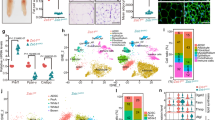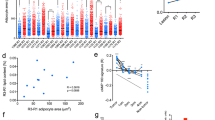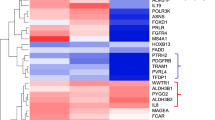Abstract
Background
Breast cancer cells that break through the basement membrane interact directly with neighboring adipocytes. Therefore, adipocytes adjacent to the invasive front of tumour undergo lipolysis and transform into cancer-associated adipocytes (CAAs), which is vital for the malignant progression of breast cancer. However, tumor-derived factors that trigger this process are still to be determined.
Methods
Transcriptome sequencing was used to identify the downstream transcription factor of adrenomedullin (AM). Tet-On system was used to construct the 3T3-L1 cell line with inducible overexpression of Zeb1. Adipocyte-specific knock-in Zeb1 transgenic mice (Zeb1adiTG) were used to construct an allograft tumor model.
Results
Breast cancer cell-derived AM downregulated the transcriptional expression of Zeb1 by triggering the cAMP/PKA/Creb1 pathway, thereby exerting lipolytic effects in CAAs. On the contrary, adipose tissue-specific upregulation of Zeb1 significantly attenuated AM-induced lipolytic phenotypes. Of note, we used the Zeb1adiTG mice to construct allograft tumor models. The results confirmed that breast cancer cell-derived AM conferred tumorigenicity in vivo, which effect was predominantly dependent on the aberrant expression of adipocyte-specific Zeb1.
Conclusions
These findings collectively suggested that breast cancer cell-derived AM promotes lipid metabolic reprogramming through a Zeb1-dependent manner in CAAs, which displays significant clinical implications and may provide promising therapeutic approaches for targeting the breast cancer-associated adipose microenvironment.
This is a preview of subscription content, access via your institution
Access options
Subscribe to this journal
Receive 24 print issues and online access
$259.00 per year
only $10.79 per issue
Buy this article
- Purchase on SpringerLink
- Instant access to full article PDF
Prices may be subject to local taxes which are calculated during checkout







Similar content being viewed by others
Data availability
The RNA-seq data generated in this study have been deposited in NCBI_SRA database under accession code PRJNA1297415 (https://www.ncbi.nlm.nih.gov/sra/?term=PRJNA1297415). All the other data supporting the findings of this study are available within the article and its Supplementary Information files.
References
Zhang, Y, Wu, M-J, Lu, W-C, Li, Y-C, Chang, CJ & Yang, J-Y Metabolic switch regulates lineage plasticity and induces synthetic lethality in triple-negative breast cancer. Cell Metab 2024;30.
Brown KA, Scherer PE. Update on adipose tissue and cancer. Endocr Rev. 2023;44:961–74.
Comerford SA, Huang Z, Du X, Wang Y, Cai L, Witkiewicz AK, et al. Acetate dependence of tumors. Cell. 2014;159:1591–602.
Zhang M, Tang C, Wang Z, Chen S, Zhang D, Li K, et al. Real-time detection of 20 amino acids and discrimination of pathologically relevant peptides with functionalized nanopore. Nat Methods. 2024;21:609–18.
Liu S, Zhang X, Wang W, Li X, Sun X, Zhao Y, et al. Metabolic reprogramming and therapeutic resistance in primary and metastatic breast cancer. Mol Cancer. 2024;23:261.
His M, Gunter MJ, Keski-Rahkonen P, Rinaldi S. Application of metabolomics to epidemiologic studies of breast cancer: new perspectives for etiology and prevention. J Clin Oncol. 2024;42:103–15.
Xie Y, Wang B, Zhao Y, Tao Z, Wang Y, Chen G, et al. Mammary adipocytes protect triple-negative breast cancer cells from ferroptosis. J Hematol Oncol. 2022;15:72.
Li Y-Q, Sun F-Z, Li C-X, Mo H-N, Zhou Y-T, Lv D, et al. RARRES2 regulates lipid metabolic reprogramming to mediate the development of brain metastasis in triple negative breast cancer. Mil Med Res. 2023;10:34.
Dorado E, Doria ML, Nagelkerke A, McKenzie JS, Maneta-Stavrakaki S, Whittaker TE, et al. Extracellular vesicles as a promising source of lipid biomarkers for breast cancer detection in blood plasma. J Extracell Vesic. 2024;13:e12419.
Shubhra QTH. RARRES2’s impact on lipid metabolism in triple-negative breast cancer: a pathway to brain metastasis. Mil Med Res. 2023;10:42.
Rossi T, Zamponi R, Chirico M, Pisanu ME, Iorio E, Torricelli F, et al. BETi enhance ATGL expression and its lipase activity to exert their antitumoral effects in triple-negative breast cancer (TNBC) cells. J Exp Clin Cancer Res. 2023;42:7.
Zhou C, He X, Tong C, Li H, Xie C, Wu Y, et al. Cancer-associated adipocytes promote the invasion and metastasis in breast cancer through LIF/CXCLs positive feedback loop. Int J Biol Sci. 2022;18:1363–80.
Huang R, Wang Z, Hong J, Wu J, Huang O, He J, et al. Targeting cancer-associated adipocyte-derived CXCL8 inhibits triple-negative breast cancer progression and enhances the efficacy of anti-PD-1 immunotherapy. Cell Death Dis. 2023;14:703.
Arora, GK, Gupta, A, Narayanan, S, Guo, T, Iyengar, P & Infante, RE Cachexia-associated adipose loss induced by tumor-secreted leukemia inhibitory factor is counterbalanced by decreased leptin. JCI Insight 2018;3.
Kim S, Oh J, Park C, Kim M, Jo W, Kim C-S, et al. FAM3C in cancer-associated adipocytes promotes breast cancer cell survival and metastasis. Cancer Res. 2024;84:545–59.
Park J, Scherer PE. Adipocyte-derived endotrophin promotes malignant tumor progression. J Clin Invest. 2012;122:4243–56.
Zhu Q, Zhu Y, Hepler C, Zhang Q, Park J, Gliniak C, et al. Adipocyte mesenchymal transition contributes to mammary tumor progression. Cell Rep. 2022;40:111362.
Wu Q, Li B, Li Z, Li J, Sun S, Sun S. Cancer-associated adipocytes: key players in breast cancer progression. J Hematol Oncol. 2019;12:95.
Wu Q, Sun S, Li Z, Yang Q, Li B, Zhu S, et al. Retraction Note: Tumour-originated exosomal miR-155 triggers cancer-associated cachexia to promote tumour progression. Mol Cancer. 2023;22:24.
Zhao D, Wu K, Sharma S, Xing F, Wu S-Y, Tyagi A, et al. Exosomal miR-1304-3p promotes breast cancer progression in African Americans by activating cancer-associated adipocytes. Nat Commun. 2022;13:7734.
Pham D-V, Park P-H. Adiponectin triggers breast cancer cell death via fatty acid metabolic reprogramming. J Exp Clin Cancer Res. 2022;41:9.
Dai W, Xiang W, Han L, Yuan Z, Wang R, Ma Y, et al. PTPRO represses colorectal cancer tumorigenesis and progression by reprogramming fatty acid metabolism. Cancer Commun (Lond). 2022;42:848–67.
Martin-Perez M, Urdiroz-Urricelqui U, Bigas C, Benitah SA. The role of lipids in cancer progression and metastasis. Cell Metab. 2022;34:1675–99.
Mohammadi Ghahhari N, Sznurkowska MK, Hulo N, Bernasconi L, Aceto N, Picard D. Cooperative interaction between ERα and the EMT-inducer ZEB1 reprograms breast cancer cells for bone metastasis. Nat Commun. 2022;13:2104.
Jiang M, Jike Y, Liu K, Gan F, Zhang K, Xie M, et al. Exosome-mediated miR-144-3p promotes ferroptosis to inhibit osteosarcoma proliferation, migration, and invasion through regulating ZEB1. Mol Cancer. 2023;22:113.
Fu R, Han C-F, Ni T, Di L, Liu L-J, Lv W-C, et al. A ZEB1/p53 signaling axis in stromal fibroblasts promotes mammary epithelial tumours. Nat Commun. 2019;10:3210.
Fu R, Lv W-C, Xu Y, Gong M-Y, Chen X-J, Jiang N, et al. Endothelial ZEB1 promotes angiogenesis-dependent bone formation and reverses osteoporosis. Nat Commun. 2020;11:460.
Xu H, Zhao J, Li J, Zhu Z, Cui Z, Liu R, et al. Cancer associated fibroblast-derived CCL5 promotes hepatocellular carcinoma metastasis through activating HIF1α/ZEB1 axis. Cell Death Dis. 2022;13:478.
Gubelmann C, Schwalie PC, Raghav SK, Röder E, Delessa T, Kiehlmann E, et al. Identification of the transcription factor ZEB1 as a central component of the adipogenic gene regulatory network. Elife. 2014;3:e03346.
Shi Y, Li F, Wang S, Wang C, Xie Y, Zhou J, et al. miR-196b-5p controls adipocyte differentiation and lipogenesis through regulating mTORC1 and TGF-β signaling. FASEB J. 2020;34:9207–22.
Martínez-Herrero, S & Martínez, A Adrenomedullin: Not Just Another Gastrointestinal Peptide. Biomolecules 2022;12.
Bálint L, Nelson-Maney NP, Tian Y, Serafin SD, Caron KM. Clinical Potential of Adrenomedullin Signaling in the Cardiovascular System. Circ Res. 2023;132:1185–202.
Zhang Q, Lee C-L, Yang T, Li J, Zeng Q, Liu X, et al. Adrenomedullin has a pivotal role in trophoblast differentiation: A promising nanotechnology-based therapeutic target for early-onset preeclampsia. Sci Adv. 2023;9:eadi4777.
Karakas M, Akin I, Burdelski C, Clemmensen P, Grahn H, Jarczak D, et al. Single-dose of adrecizumab versus placebo in acute cardiogenic shock (ACCOST-HH): an investigator-initiated, randomised, double-blinded, placebo-controlled, multicentre trial. Lancet Respir Med. 2022;10:247–54.
Voordes G, Davison B, Biegus J, Edwards C, Damman K, Ter Maaten J, et al. Biologically active adrenomedullin as a marker for residual congestion and early rehospitalization in patients hospitalized for acute heart failure: Data from STRONG-HF. Eur J Heart Fail. 2024;26:1480–92.
Chacron MJ. The role of ADM in brain function. Nat Comput Sci. 2022;2:628–9.
Oehler MK, Norbury C, Hague S, Rees MC, Bicknell R. Adrenomedullin inhibits hypoxic cell death by upregulation of Bcl-2 in endometrial cancer cells: a possible promotion mechanism for tumour growth. Oncogene. 2001;20:2937–45.
Tanaka M, Koyama T, Sakurai T, Kamiyoshi A, Ichikawa-Shindo Y, Kawate H, et al. The endothelial adrenomedullin-RAMP2 system regulates vascular integrity and suppresses tumour metastasis. Cardiovasc Res. 2016;111:398–409.
Lv Y-P, Peng L-S, Wang Q-H, Chen N, Teng Y-S, Wang T-T, et al. Degranulation of mast cells induced by gastric cancer-derived adrenomedullin prompts gastric cancer progression. Cell Death Dis. 2018;9:1034.
Sagar G, Sah RP, Javeed N, Dutta SK, Smyrk TC, Lau JS, et al. Pathogenesis of pancreatic cancer exosome-induced lipolysis in adipose tissue. Gut. 2016;65:1165–74.
Nakayama, A, Roquid, KA, Iring, A, Strilic, B, Günther, S, Chen, M, et al. Suppression of CCL2 angiocrine function by adrenomedullin promotes tumor growth. J Exp Med 2023;220.
Zhou X, Zhang J, Lv W, Zhao C, Xia Y, Wu Y, et al. The pleiotropic roles of adipocyte secretome in remodeling breast cancer. J Exp Clin Cancer Res. 2022;41:203.
Choi J, Cha YJ, Koo JS. Adipocyte biology in breast cancer: From silent bystander to active facilitator. Prog Lipid Res. 2018;69:11–20.
Bouche C, Quail DF. Fueling the tumor microenvironment with cancer-associated adipocytes. Cancer Res. 2023;83:1170–2.
Conway JRW, Dinç DD, Follain G, Paavolainen O, Kaivola J, Boström P, et al. IGFBP2 secretion by mammary adipocytes limits breast cancer invasion. Sci Adv. 2023;9:eadg1840.
Zhao C, Wu M, Zeng N, Xiong M, Hu W, Lv W, et al. Cancer-associated adipocytes: emerging supporters in breast cancer. J Exp Clin Cancer Res. 2020;39:156.
Gao Y, Chen X, He Q, Gimple RC, Liao Y, Wang L, et al. Adipocytes promote breast tumorigenesis through TAZ-dependent secretion of Resistin. Proc Natl Acad Sci USA. 2020;117:33295–304.
Dai K, Tanaka M, Kamiyoshi A, Sakurai T, Ichikawa-Shindo Y, Kawate H, et al. Deficiency of the adrenomedullin-RAMP3 system suppresses metastasis through the modification of cancer-associated fibroblasts. Oncogene. 2020;39:1914–30.
Metellus P, Voutsinos-Porche B, Nanni-Metellus I, Colin C, Fina F, Berenguer C, et al. Adrenomedullin expression and regulation in human glioblastoma, cultured human glioblastoma cell lines and pilocytic astrocytoma. Eur J Cancer. 2011;47:1727–35.
Martínez A, Vos M, Guédez L, Kaur G, Chen Z, Garayoa M, et al. The effects of adrenomedullin overexpression in breast tumor cells. J Natl Cancer Inst. 2002;94:1226–37.
Larrue C, Guiraud N, Mouchel P-L, Dubois M, Farge T, Gotanègre M, et al. Adrenomedullin-CALCRL axis controls relapse-initiating drug tolerant acute myeloid leukemia cells. Nat Commun. 2021;12:422.
Gyamfi J, Lee YH, Eom M, Choi J. Interleukin-6/STAT3 signalling regulates adipocyte induced epithelial-mesenchymal transition in breast cancer cells. Sci Rep. 2018;8:8859.
Gyamfi J, Eom M, Koo JS, Choi J. Multifaceted Roles of Interleukin-6 in Adipocyte-Breast Cancer Cell Interaction. Transl Oncol. 2018;11:275–85.
Luis G, Godfroid A, Nishiumi S, Cimino J, Blacher S, Maquoi E, et al. Tumor resistance to ferroptosis driven by Stearoyl-CoA Desaturase-1 (SCD1) in cancer cells and Fatty Acid Biding Protein-4 (FABP4) in tumor microenvironment promote tumor recurrence. Redox Biol. 2021;43:102006.
Acknowledgements
This work was supported by grants from the International Science and Technology Cooperation Project of China (No. 2022YFE0133300) and the National Natural Science Foundation of China (No. 82472870; No. 82172801).
Author information
Authors and Affiliations
Contributions
XC and LC contributed to conceptualisation, methodology, data curation, and writing—original draft. MF and QS performed visualisation, methodology, investigation, and formal analysis. MG, ZL, CQ, JS, and SZ carried out methodology and formal analysis. YL, TY, HH, YW, and YX contributed to methodology and conceptualisation. PS and YS conducted visualisation and validation. HW provided resources and funding acquisition. LL supervised the study, provided resources, secured funding, and participated in data curation, conceptualisation, and writing—review & editing. SY supervised the study, provided resources, project administration, and funding acquisition, and contributed to visualisation, methodology, formal analysis, data curation, conceptualisation, and writing—review & editing. All authors read and approved the final version of the manuscript.
Corresponding authors
Ethics declarations
Ethics Approval And Consent To Participate
The study was conformed to the principles of the Declaration of Helsinki, and all of the experimental procedures involving animals were performed in accordance with a protocol that was approved by the Ethics Committee for Animal Use at the Medical College of Nankai University (2022-SYDWLL-000096).
Competing interests
The authors declare no competing interests.
Additional information
Publisher’s note Springer Nature remains neutral with regard to jurisdictional claims in published maps and institutional affiliations.
Supplementary information
Rights and permissions
Springer Nature or its licensor (e.g. a society or other partner) holds exclusive rights to this article under a publishing agreement with the author(s) or other rightsholder(s); author self-archiving of the accepted manuscript version of this article is solely governed by the terms of such publishing agreement and applicable law.
About this article
Cite this article
Chen, X., Cao, L., Feng, M. et al. Breast cancer cell-derived adrenomedullin confers cancer-associated adipose remodeling through the cAMP/Creb1/Zeb1 axis. Br J Cancer (2025). https://doi.org/10.1038/s41416-025-03219-7
Received:
Revised:
Accepted:
Published:
DOI: https://doi.org/10.1038/s41416-025-03219-7



